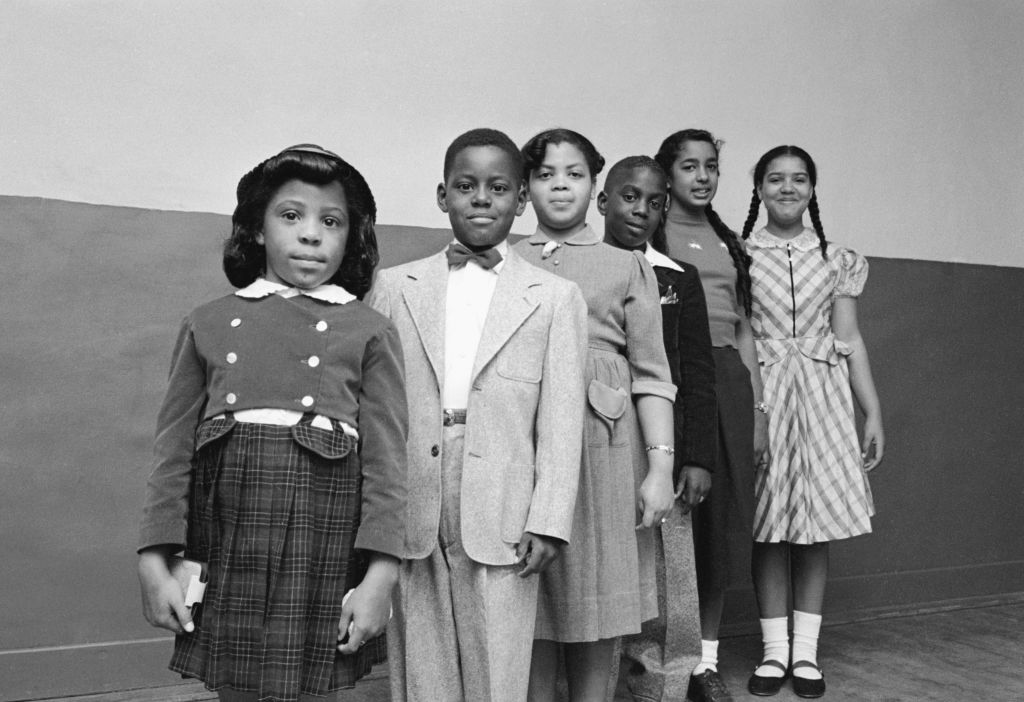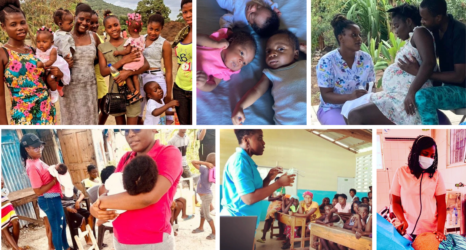“Brown was intended to end segregation.” Seventy years later, psychologist Margaret Beale Spencer and attorney Nancy E. Dowd investigate what went wrong on the road to equality.

When the U.S. Supreme Court struck down the “separate but equal” doctrine that allowed public schools to segregate students by race in 1954, it opened the possibility of radical change. But 70 years later, the promise of Brown v. Topeka Board of Education has yet to be realized.
Psychologist Margaret Beale Spencer and attorney Nancy E. Dowd, authors of Radical Brown: Keeping the Promise to America’s Children, interrogate why progress has been slow and uneven. Their searing analysis zeroes in on the academic and emotional development of children of color and white children and concludes that “children of color are treated as less human,” while white children are “imbued with crippling lessons of inhumane racial supremacy” that carry into adulthood. The result is obvious: “Since Brown, three generations of inattentiveness to our common humanity” has resulted in continued educational segregation.
The upshot, they conclude, is that educational inequalities are pervasive not because of Brown, but in spite of it.
Beale Spencer and Dowd spoke to Ms. reporter Eleanor J. Bader several weeks before the book’s May 7 release by Harvard Education Press.

Eleanor J. Bader: Why did you decide to write a book about the Brown decision?
Nancy E. Dowd: At one point, I was the director of the Center on Children and Families at the University of Florida Levin College of Law.
About six years ago, the Center decided to sponsor a two-day conference on early childhood education. I was familiar with some of Dr. Beale Spencer’s work and suggested her as the keynote speaker. Everyone agreed that she’d be fantastic. She came to Florida and after her lecture on the Brown decision, our law review decided to publish her remarks. In the process of readying the manuscript for publication, I told Margaret that I thought we should write a longer article about the decision. She responded by saying, ‘No, we should write a book.’
That’s how it started. We both had very busy schedules but we talked every week or every other week, met a few times in person, and built what we both see as a unique relationship. The writing process was actually extraordinary.
Bader: We’re currently in a period of intense backlash against books about race, racism, sexuality, and gender identity, as well as the teaching of accurate accounts of history. How can educators continue to do anti-racist work?
Margaret Beale Spencer: We have to encourage people to look in the mirror, acknowledge their own humanity, and see a connection to other human beings.
It also includes recognizing shared human vulnerability. We need to recognize the false notion of white superiority that this country’s founders pushed forward. White men brought African slaves to the U.S. to buttress the new nation’s economic stability. This was based on the dehumanization of Black people, a factor that has had a lingering impact on race relations. This impact has been under-addressed for 300-plus years. Although there are many examples of personal resilience, it also means that individuals of color are burdened with conditions of high risk, while having access to inconsistent and inadequate supports.
This has had a lingering impact on gender relations, since white men have also exerted superiority over white women. This has not sensitized most white women to the problem of dehumanizing others.
The challenge for me, as a psychologist, is to address this from a perspective that promotes freedom by helping people find their purpose—not on a false foundation of white or male superiority, but by embracing real character development. At the same time, we need to acknowledge the unevenness of opportunity and variability in shared human vulnerability.
Dowd: It might be sheer fantasy on my part, but I see the strong backlash we’re facing as a response to the movements for racial and gender justice. I have to hold onto hope that a critical mass of people in the United States cares about equity, want it and will work to make it happen.
The Brown decision has been used as an excuse—as if to say, ‘We have this famous decision on paper, so we don’t have to take significant steps to change things.’
Nancy E. Dowd
Dowd: In addition, white, heterosexual masculinities—what men place value on—actually harm them. The price of racism and sexism is toxic to their humanity; it’s unfair. Overall, this system has been set up to render invisible the subordination of people of color and all women.
Finally, I think that the Brown decision has been used as an excuse—as if to say, ‘We have this famous decision on paper, so we don’t have to take significant steps to change things. After all, we ended formal segregation.’ But people should feel uncomfortable talking about race. Feeling unsettled provides us with opportunities to disrupt white privilege and the normalization of Black dehumanization.
Lastly, white folks need to be aware of how they move through the world. We want them to notice how they engage with Black people. In my lifetime, I’ve witnessed racism as well as racial progress. Race and the interplay between race and gender are complex and deep, but those who tell us that we need to go back to the 1950s to ‘make America great again’ are promoting a false narrative.
Beale Spencer: The everyday expressions of Black dehumanization are clear.
White women, unfortunately, know that they have been plagued by positionality, deemed lesser than white men. But we also need to call out their behavior when it comes to race—since, as noted, many white women forget their victimization when it’s election time or when it comes to preserving their racial advantages. This needs to be understood and denounced.
Nonetheless, there is heterogeneity within white communities, and some white people have been able to embrace the humanity of others. No one to date has researched why this happens. We need to probe the supports and other factors that push some people to accept our shared humanity and the varied contributors to our shared human vulnerability.
Identity is always fragile and some people in all communities are okay with trampling others or promoting avarice. We need to research why this happens. This is not a scientific question but it contributes to blindspots in the social sciences. Although unaddressed privilege can be pathologizing, we need to face and investigate the mechanisms of it frontally if we are going to create programs that support all kids and enable those saddled by the ‘downside of privilege’ to embrace their full humanity and the humanity of others.
Bader: In Radical Brown, you write that segregation policies originated in the northern U.S. This underscores the distortion at the center of too many accounts of American history and the still pervasive idea that racism was, and still is, due to Southern bigotry.
Dowd: History has frequently been whitewashed to underplay how unbelievably comprehensive segregation was in its formal and informal reach. It was a national problem and it applied to anyone who was not considered white. We know that whiteness itself is a created concept. Knowing that informs our understanding of the present.
If you look at segregation and how it worked to divide people, you can see how ideas about race have been transmitted intergenerationally.
This continues today. It is important for students to look at who they go to school with, who lives in their neighborhood and who their parents work alongside. What are the patterns of race in your life and in your community?
What we see today is linked to history. When we don’t have an awareness of this, it leads to denial. None of us know what it would be like to live in a society where everyone is equal. Sure, there’s been progress since Brown. But in 70 years, we should be farther along in education and in promoting social justice more widely.
Beale Spencer: The bottom line is that students are not taught to see history as part of present-day realities.
Brown was intended to end segregation, but it did this by putting Black kids in white schools. It did not value the contributions of Black teachers and principals; it assumed all-white settings were the only ones of value. It was fictional thinking to assume that Brown would end segregation and racism.
We now need a comprehensive, equality determinative-enforcing strategy, so that no matter where a school is located or who attends it, psychological and physical health and well-being are components of what is taught. Youth are smart; they can see situations that advantage some kids and disadvantage others. This impacts the totality of their human development and is evident from early childhood into adulthood.
We need to recognize the false notion of white superiority that this country’s founders pushed forward.
Margaret Beale Spencer
Bader: Social and Emotional Learning (SEL) has been promoted as a way to build self-esteem and respect between people. Do you think it’s effective?
Beale Spencer: SEL can be useful, but it depends on who structures it and what sources it utilizes. Social and emotional learning has to go deeper than language; specifically, it has to go beyond diversity, equity, and inclusion-relevant words. Unfortunately, everyday behaviors and socially relevant interactions, particularly for those holding power, are often ignored. This means that opportunities for self-reflection are ignored, too. Occasions to build an enhanced recognition of each person’s inherent value rarely take place.
Dowd: We know that Diversity, Equity and Inclusion programs, like SEL, have sometimes been presented in surface ways, but both can be effective depending on who is implementing them and whether they zero in on the developmental needs of each child.
Bader: How can schools of education better prepare students to do this in their classrooms?
Beale Spencer: We have research assessments that function as tools to determine whether teachers actually identify with their students. This understanding is necessary for students’ learning and intellectual risk-taking and is a needed aspect of teachers’ social and emotional development and identity. The use of assessment tools helps teachers identify gaps in their teaching strategies and helps them see what extra support they need to reach maximal effectiveness.
Dowd: Every academic program communicates which classes are required and which are electives. This tells us what a college values and what it sees as less important. Once people become teachers, they can get support at conferences, through ongoing coaching, and from supervisors or colleagues who can suss out conscious and unconscious biases about race, class, or gender.
Schools should want every teacher to reach every child. This requires delving into grading and discipline policies and doing substantive evaluations to understand classroom dynamics and their impact.
None of us know what it would be like to live in a society where everyone is equal. … But in 70 years, we should be farther along in education and in promoting social justice more widely.
Dowd
Bader: Schools often give lip service to the idea of equality when what is needed is equity to level the schoolroom playing field.
Dowd: One size does not fit all. The racial and ethnic mix is different in different regions of the country. There may have been—or maybe still are—Klan or white supremacist movements in a locality. There may be limited social interactions between different races in schools due to Magnet programs that segregate students. Overall, we know that the general situation of kids of color and white kids is not the same; we have to make the foundation more equitable. Tangible changes matter. Funding is grossly unequal both between states and within states. In fiscal 2023 for example New York spent the most of any state, $29,897 per student, while Idaho spent the least: $8662.
The variability is enormous and that alone has a significant impact on learning. If we were to create an equal system, changing the way funding is allocated would be a good start.
Beale Spencer: We also need to be sensitive to the students’ material conditions and provide other needed supports to them and their communities so that everyone has an equitable start in life. Many students of color are vulnerable because of economic disparities.
A better outcome for everyone’s thriving and well-being requires economic, health, dietary and housing supports, as well as the resources necessary—from books to computers to library access to school buildings and campuses that have not deteriorated. This is the only way to promote equity between schools and respect for every student. But as we write in ‘Radical Brown,’ the way forward begins with an unwavering dedication to Brown’s principle of shared humanity.
Up next:
U.S. democracy is at a dangerous inflection point—from the demise of abortion rights, to a lack of pay equity and parental leave, to skyrocketing maternal mortality, and attacks on trans health. Left unchecked, these crises will lead to wider gaps in political participation and representation. For 50 years, Ms. has been forging feminist journalism—reporting, rebelling and truth-telling from the front-lines, championing the Equal Rights Amendment, and centering the stories of those most impacted. With all that’s at stake for equality, we are redoubling our commitment for the next 50 years. In turn, we need your help, Support Ms. today with a donation—any amount that is meaningful to you. For as little as $5 each month, you’ll receive the print magazine along with our e-newsletters, action alerts, and invitations to Ms. Studios events and podcasts. We are grateful for your loyalty and ferocity.





